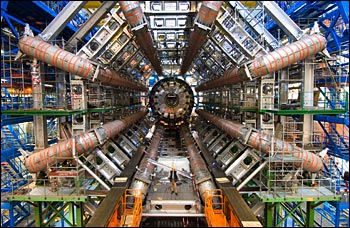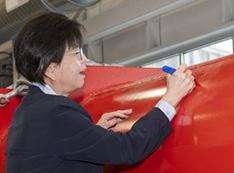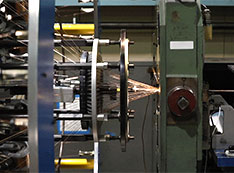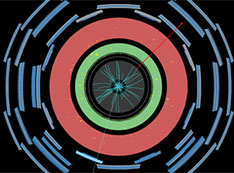Contact: Peter Genzer, (631) 344-3174 | Written by Justin Eure
The University of Texas at Arlington issued the following news release on Friday, Sept. 7. Scientists from the U.S. Department of Energy’s Brookhaven National Laboratory played key roles in both the search for the Higgs boson and the development of the associated technology.
For more information about Brookhaven’s role, contact Justin Eure, jeure@bnl.gov, 631-344-2347, or Peter Genzer, genzer@bnl.gov, 631-344-3174.
UT Arlington Media Contact: Traci Peterson, tpeterso@uta.edu, 817-272-9208
U.S. Collaborators to Make Higgs-hunting Tech Available
Key data software used to discover the Higgs particle will be applied to research in medicine, astrophysics, and more.
September 10, 2012
The University of Texas at Arlington is teaming with the U.S. Department of Energy’s Brookhaven and Argonne national laboratories to develop a universal version of PanDA, a workload management system built to process huge volumes of data from experiments at the Large Hadron Collider in Geneva, Switzerland.

ATLAS detector
The new project will bolster science and engineering research that relies on “big data,” a priority recently promoted by The White House. The U.S. Department of Energy’s Office of Advanced Scientific Computing Research has awarded a combined $1.7 million to Brookhaven and UT Arlington to fund the PanDA work over the next three years.
“PanDA has been an extremely useful piece of software. We could not have found the Higgs without it,” said Kaushik De, a physics professor and director of UT Arlington’s Center of Excellence for High Energy Physics. “It’s been used by thousands of physicists around the world. We thought, ‘Wouldn’t it be nice if we repackaged it so others could use it too?’ So, we proposed generalizing PanDA as a meta-application.”
UT Arlington and Brookhaven developed PanDA for use by the ATLAS collaboration, a particle physics experiment at the Large Hadron Collider at CERN. ATLAS includes 3,000 physicists from UT Arlington and more than 170 other institutions, 40 of which are in the U.S. In July, it was one of the groups that made headlines by announcing the discovery of a new particle that scientists said could be the Higgs boson, also known as the “God particle.”
The computing hardware associated with ATLAS is located at 100 computing centers around the world that manage more than 50 petabytes, or 50 million gigabytes, of data. PanDA links the computing centers and allows scientists to efficiently analyze the tens of millions of particle collisions taking place at the Large Hadron Collider each day. In addition to De’s work developing PanDA, UT Arlington is home to the ATLAS Southwest Tier 2 grid computing center.
“The collaboration between UT Arlington and Brookhaven National Laboratory was established a long time ago and it is a very successful story,” said Alexei Klimentov, Physics Applications Software Group Leader at Brookhaven. “We are physicists, and we developed this software to be used by a high-energy physics experiment. But very soon we realized that it could be used in other areas, such as astro-particle physics, biomedicine and others.”
As an example of the possible applications, officials at the Alpha-Magnetic Spectrometer, or AMS, are considering adopting PanDA software, De said. AMS is an International Space Station experiment looking for dark matter in the universe.
In March, the Obama administration announced the “Big Data Research and Development Initiative,” a $200 million investment in tools to handle huge volumes of digital data needed to spur science and engineering discoveries. At that announcement, White House officials highlighted the Energy Department’s Office of Advanced Scientific Computing Research as key to that ongoing effort.
PanDA – which was created with funding from the National Science Foundation and the Department of Energy’s Office of High Energy Physics – was cited as an example of successful technology already in place.
Klimentov is the principal investigator on the new computing grants. De and Gergely Zaruba, an associate professor of computer science and engineering at UT Arlington, are co-principal investigators for UT Arlington’s portion, which totals $704,488. The grant to Brookhaven will total $997,000 over three years. Other key scientists include: Alexandre Vaniachine, of Argonne National Lab; and Torre Wenaus, Dantong Yu and Sergei Panitkin, all of Brookhaven.
Klimentov said one of the major challenges of the new project would be to extend the grid-based PanDA system to a cloud-computing platform. He and De agree that work on the project would undoubtedly improve the capacity of the current PanDA system as it’s used by ATLAS.
The “big data” project is an example of innovation under way at UT Arlington, a comprehensive research institution of nearly 33,500 students in the heart of North Texas. Visit www.uta.edu to learn more.
DOE’s Office of Science is the single largest supporter of basic research in the physical sciences in the United States, and is working to address some of the most pressing challenges of our time. For more information, please visit science.energy.gov.
2012-11451 | INT/EXT | Newsroom







